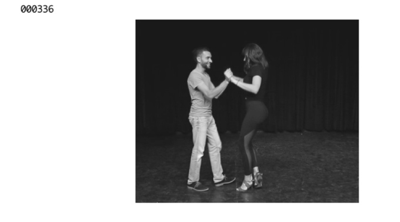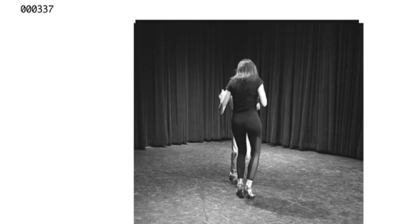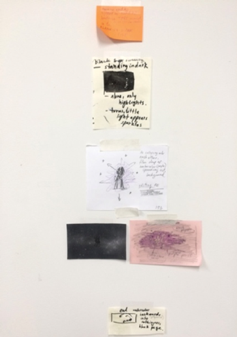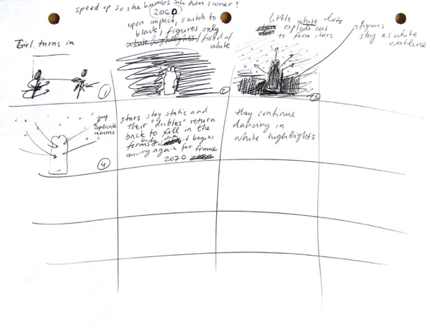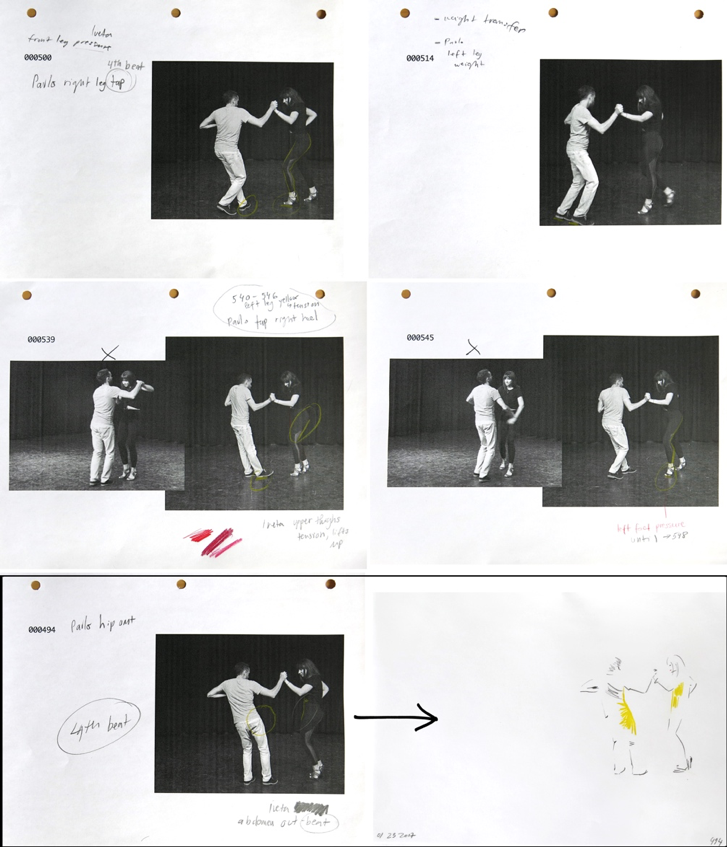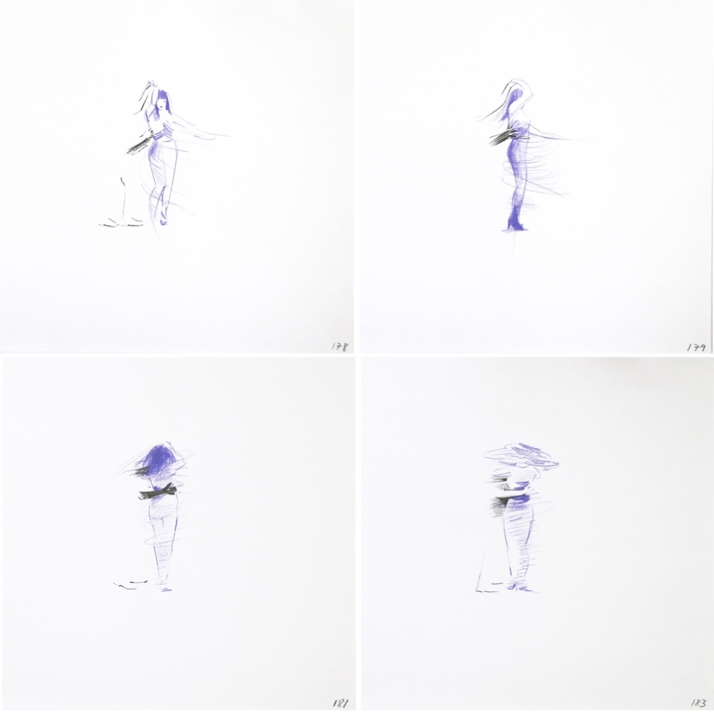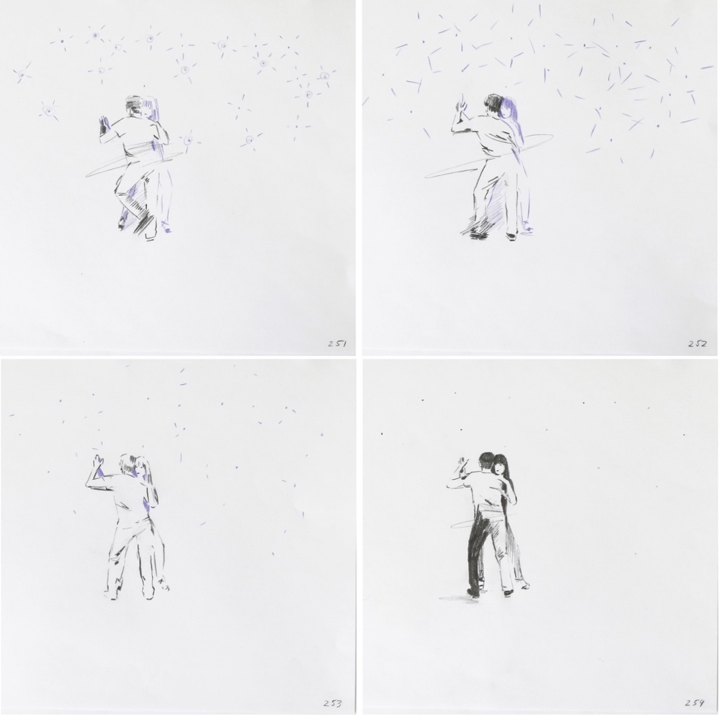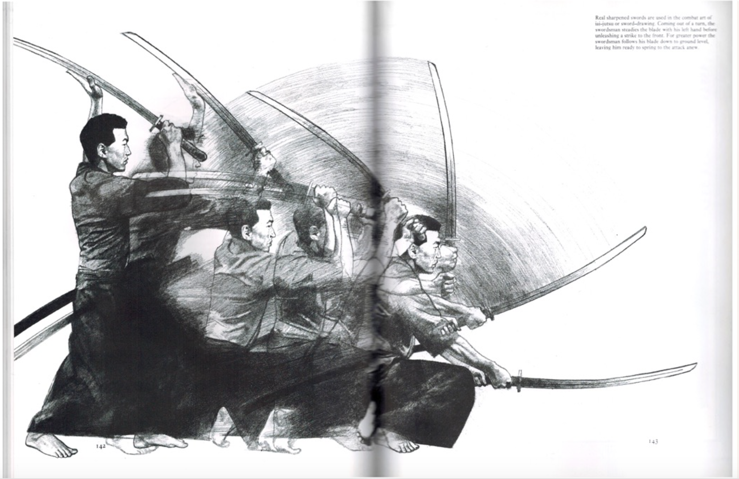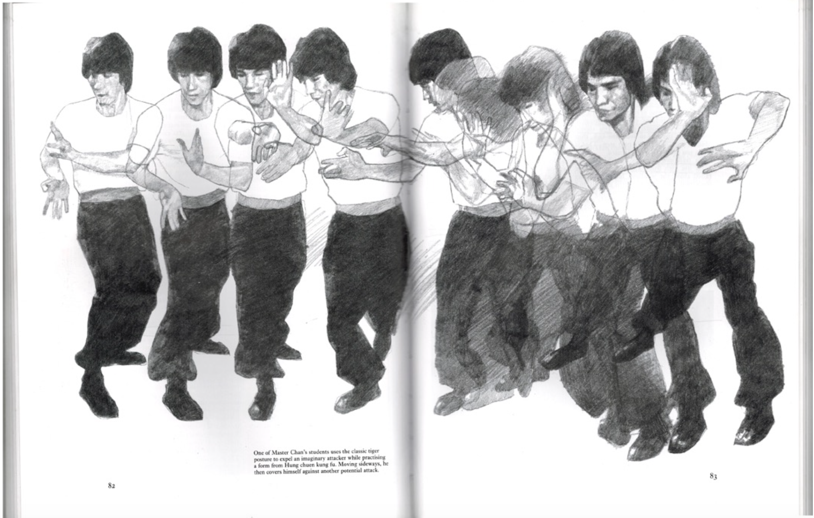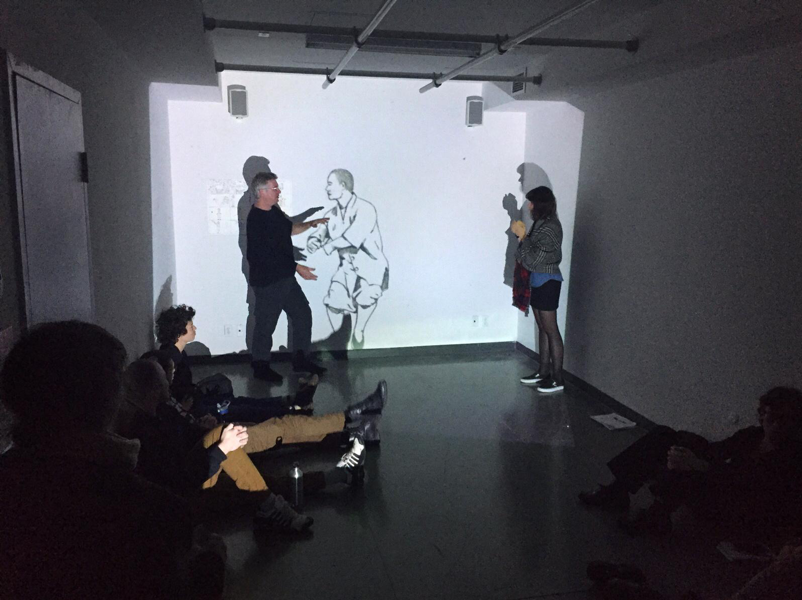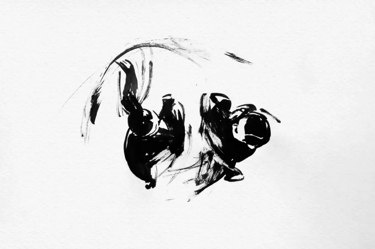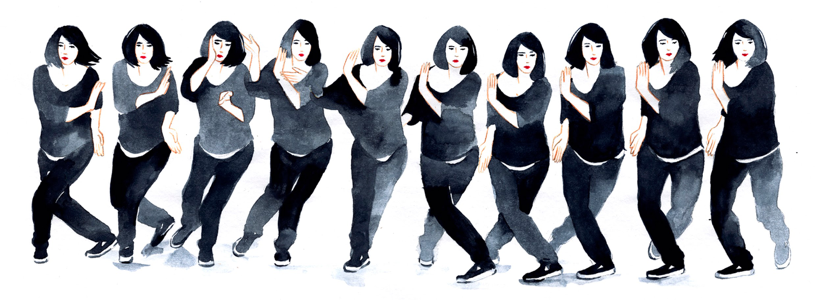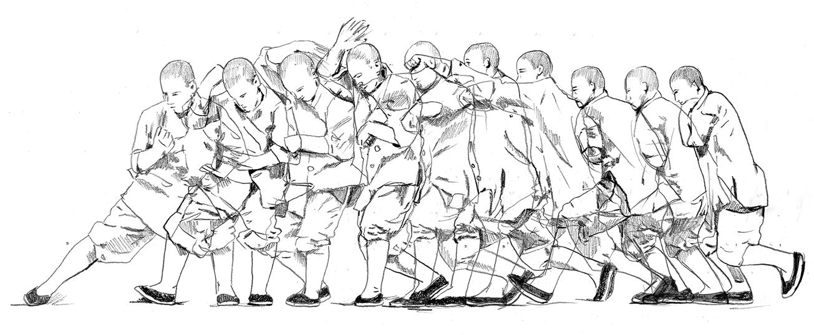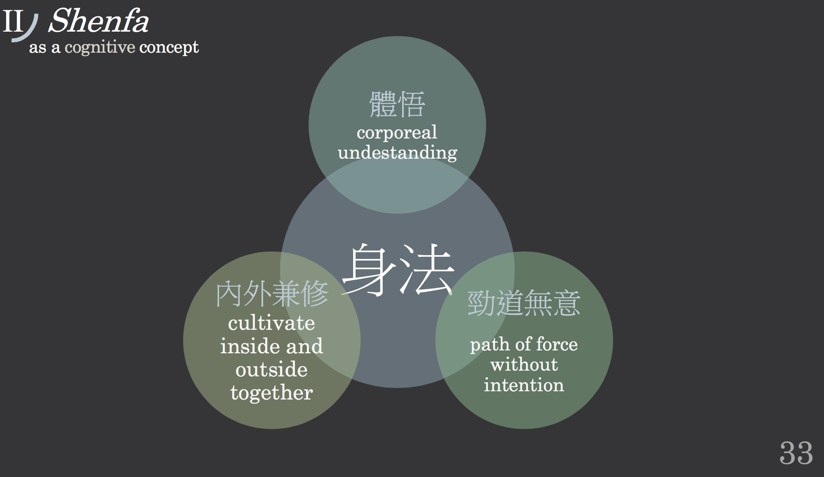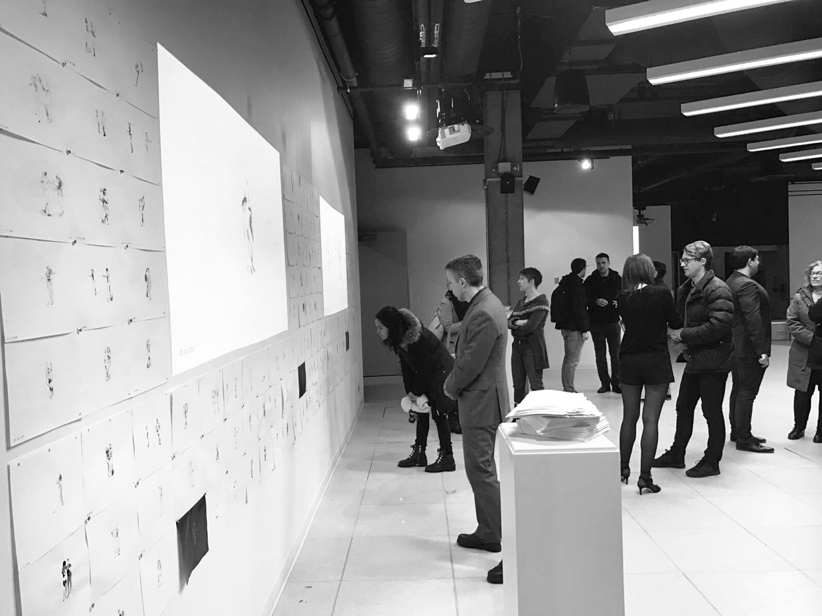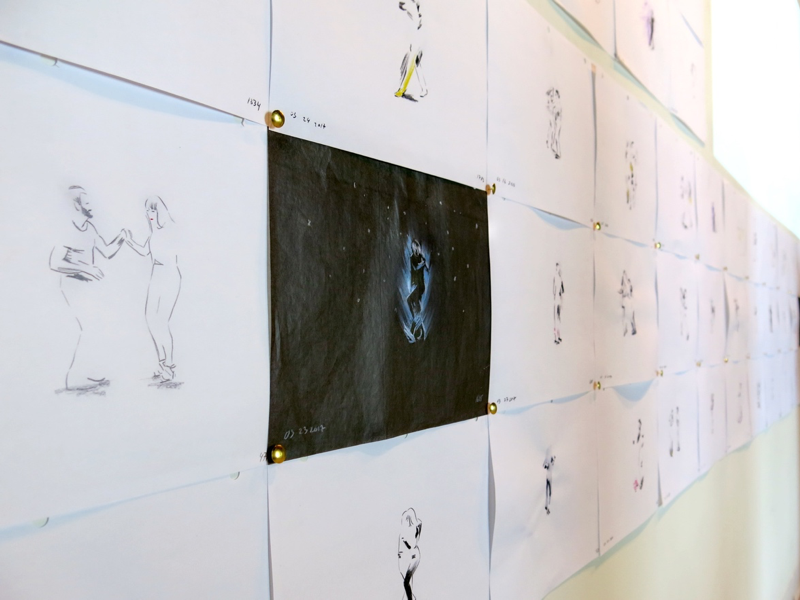What about knowledge of embodiment? What about the possibilities afforded to us as bodily beings? …Embodied technique remains a vital area of ongoing exploration, in which the potential for valuable new discoveries has in no way been exhausted. (Spatz, 2015, pp.4-5)
My methods of inquiry were grounded in research on embodiment relatable to my practices of traditional animation, Latin dancing and martial arts. As a self-reflexive study grounded in awareness of my making techniques, I observed body-centric techniques in my primary discipline of animation to frame it as a practice linked to embodied knowledge but also as a media capable of documenting embodied research through strategic design development. With creative work as the final output, my studio-based film project Phases of Dance (view the film here) integrated a writing reflection on my physical process of drawing 100 frames per day and a full rotoscoping production focused on animation design for capturing bachata technique in movement, performance and musicality. To keep animation as an organic process of learning which could be observed as an embodied practice, I chose not to interrupt my studio creation with line testing. Instead of this regular check on the progress of the 3:40min film, the 2,100 hand-drawn frames were photographed in one run upon completion. Phases of Dance thus functions not only as a documentation of bachata technique in rotoscoping of my dance performance but also as a chronologic record of embodied learning in animation that shows my progress in drawing, painting, and understanding of motion with frame 1 drawn on Jan 9th and frame 2,100 on March 27th 2017.
The scope of this research focuses on a practical outcome through sustained creative practice. Phases of Dance can be seen as a response to Ben Spatz’s theory of embodiment, whereby practice can only be qualified as research within academia if it can be documented through multimedia publications in order to produce a scholarly archive of knowledge dissemination. The theory of embodied technique as knowledge by Dr. Ben Spatz, author and Senior Lecturer in Drama, Theatre and Performance, has strong implications on the role of practice as research within scholarly discourse. “Implicit in the tension between theory and practice is the idea that ‘practice’ is not epistemic in nature. It is assumed, in other words, that ‘knowing’ is a matter of ‘thinking’ rather than ‘doing’” (Spatz, 2015, p.223). This production-based research speaks to modes of knowing as related to my bodily practices while the short film functions as a creative output of my design-based inquiries in documenting technique in dance and animation. In the course of this investigation, I also reflected on the modes of training in my practices of dancing and martial arts to compare and synthesize what knowledge is generated in the process of embodied learning in relation to my primary discipline of classical animation.
The research sought to answer the following research questions: What are the affordances of traditional animation rotoscoping as a record of embodied technique? What is the epistemic structure of embodied practices? How can we document practice as research within university academic discourse?
1.1. Theory: Embodied Technique as Knowledge
My research is grounded in the theoretical framework proposed by Spatz in his book What a Body Can Do: Technique as Knowledge, Practice as Research (2015) that frames embodied technique as knowledge and proposes that a practitioner’s bodily technique should be observed as a type of knowledge production conducted on daily basis in studios, training sessions, classes or rehearsals (p. 6). In framing traditional animation as a discipline of embodied knowledge, I observed my body and mind-related processes that surface in the act of drawing and visualizing the final project. In the process I became more aware of my animation practice as grounded in the repetitive action of producing sequential frames, drawing reflexes, self-expressive gestural articulation but also a predisposition to think in relation to motion and time. Such insights on my tendencies in body learning and articulation were further substantiated as I drew connections to techniques in my other embodied practices of Latin dancing and martial arts. Spatz (2015, p. 44) claims that technique is a “know-what” which as a research outcome outlines “what can be gleaned through an informed reflexivity about the process of making and its modes of knowing”. This can be achieved through the method of critical reflection – pausing, standing back and thinking about what you are doing. It is important to note that embodied technique refers to embodiment encompassing “the possibilities afforded to us as bodily beings” (Spatz, 2015, p. 4) and includes not only physical movement but also mindful thought process, intellect and rationality. From an academic perspective where the end goal is knowledge dissemination, this type of theory opens up an important discussion on the authority of embodied technique as a field of body-centric knowledge that needs to be researched through practice and in the process produces documented practical outcomes.
While this research explores animation as a form of embodied knowledge, my investigation is two-fold as it considers the affordances of animation in documenting my embodied technique of bachata dancing. Spatz (2015, p. 242) argues that “[t]he debate around documentation would substantially shift if we were to stop trying to capture works of art and instead try to document “art” itself – that is, technique.” As described in the Animation Design section, I use various approaches in rendering movement that seek to capture and emphasize the epistemic structure of a particular gesture or performative element in bachata. Spatz is proposing multimedia projects as a solution towards documentation, in particular the format of video .
1.2. Methodology: Embodied Research
This research uses embodied research methodology which seeks to ground the researcher’s activity in the act of doing and evolving in their bodily practice in the space of the studio. As described by Spatz (2016) in his keynote presentation at the Martial Arts Studies Conference, it is not uncommon in academic discourse to use embodied research as a tactic in order to add knowledge to the fields of sociology, anthropology or history. However, it tends to play a secondary role whereby a researcher analyzes a group through their ways of doing or joins their practice to observe his or her own experience in relation to them through ethnography. In contrast, Spatz’s methodology is specific to practice-based research and I am using it as a model to reflect on my three disciplines of traditional animation, bachata dance and kung fu in relation to embodiment, generating an interdisciplinary research approach in order to draw conclusions on their shared epistemology. In accordance to this methodology, as a researcher I was investigating my own embodied practices with a focus on rotoscoping technique that can proceed to circulate through Phases of Dance as a documented outcome.
In the process of rotoscoping animation, which entailed ongoing frame by frame study and observing of bodies in motion in my eight studio projects with particular focus on bachata technique in Phases of Dance (Chapter 3), I begun to think more and more about my own body and how I use, learn and express myself through it in animation, dance and martial arts. I progressively started to analyze interdisciplinary connections that are linked to bodily technique and my last section (Chapter 4) outlines these findings, which aim to frame traditional animation practice in the context of embodied knowledge. Observing my physical and mental processes of animation, I reflected on how my body is conditioned over time and learns to recognize connections between movement and timing through an ongoing two-month studio regime where I drew on a daily basis.
In relation to my professional qualifications and personal interest in this research, I have been a commercial illustrator focusing on drawing and watercolour painting since 2010 and currently work as a workshop instructor at the Toronto Animated Image Society with a focus on hand-drawn animation. I began training in Latin dancing and kung fu in 2013 and continue to expand my practice in the role of bachata and salsa assistant instructor as well as a dancer on a professional performance team practicing routines on weekly basis. These experiences facilitated my academic examination of embodied practices as methods of primary research. I observed what bodily knowledge was generated in training and rehearsals and the components that need to be progressively learned from the very basic level of solid foundations to mastery of a technique.
Literature Review
2.1. Animation for the Study of Embodiment
As the final outcome of my studio-based project I research rotoscoping animation and its design potential in highlighting the epistemic nature of my embodied practice of dancing. Commenting on the historically recent emergence of video-based formats as a way of documentation, Spatz (2015, p. 240) notes that “scholarly notions of performance and embodied practice have emerged from the growth of multimedia technologies precisely because these technologies can so successfully record aspects of practice – like movement and rhythm – that otherwise could not be archived.” At its very heart, animation is a creative practice whose design is specific to the study, translation and capturing of motion. I find my views associate most closely with pioneering Canadian animator Norman McLaren, who believed that “the ‘purer’ the cinema, the more it communicates its essential information, thoughts and feelings…by the means of motion, with little or no reliance on factors other than motion” (1991, p.17). In the repetitive labor-intensive process of hand- drawn animation, I find myself analyzing the embodied elements of bachata dance and rendering only the parts and motions relevant to the execution of a technique I aim to emphasize. As described in my animation design section, I tend to leave out limbs that the viewer assumes are there as referred to by the motion or use simple forms of color blocking to draw attention to a crucial point of impact (See Figure 13 below: Frames 492-495, p.16 and Figure 15: Frames 178, 179, 181 and 183, p.19). As such, traditional animation had the tendency to be efficient in capturing only the vital parts of a movement or feeling in a performance. As observed by McLaren (1991, p.43), in “animated film, there is a very practical reason. It just cuts down on the amount of labor – anything not essential to the behavior…I don’t know if painters like Klee had that practical motive; because it’s very easy to add additional lines to a drawing or a painting. It’s not going to mean doing it 1000 times.”
Conforming to the needs of movement in animation allows for a practical simplification in style and rendering only parts of movement or bodily technique judged as essential. Having concentrated on the technique of rotoscoping allowed me to produce animations that are in line with actual real-life footage and kept my visual interpretation within the context of specific bodies in movement. Bob Sabiston, the animation director of Waking Life (2001) and creator of Rotoshop software program, describes rotoscoping as a technique that mediates performance and offers a wide range of possibilities to creatively capture movement through its relationship with photorealism, tracing and gestural interpretation of real-life capture (Auping, 2009, pp.76-79).
My interest in sequential art as a means of capturing movement was first stimulated with Mike Bell’s illustrations in the book The Way of the Warrior: The Paradox of the Martial Arts (See Appendix A – Figure 1: An iai-jutsu (sword-drawing) set, p.34, and Figure 2: A kalaripayit set p.34, and Figure 3: A kung fu set, p.35). These visuals demonstrated and clarified a set of forms from various martial arts through the design process of traditional animation whereby a body was shown rendered frame by frame, representing various stages of motion. In its basic principle of drawing pictures in time, animation can offer insights into the study of embodiment through “isolating selected movements that in real life would be a continuous chain of activity” (Halas and Manvell, 1962, p.8). In the book Design in Motion, John Halas and Roger Manvell frame animation as a creative practice historically grounded in the studies of bodily motion but also outlines its design-based logic that turns static bodies into a moving action performed within the dimensions of space and time. In my first year of studio work I experimented with animation techniques in large scale painting (See Appendix A – Figure 4: Large scale, p.35), life-size projection (See Figure 5: Life-size projection, p.36), abstracted gesture painting (See Appendix A – Figure 6: Abstracted gesture painting, p.36) and GIF-based looped motion sequences (See Appendix A – Figure 7: Frames from the GIF-based looped sequence, p.37). I explored the qualities of watercolor, ink and pencil and their efficiency in conveying movement, using kung fu as a case study (See Appendix A – Figure 8: Exploring the qualities of watercolor, p.37 and Figure 9: Exploring the qualities of pencil media, p38.).
In my final year I have been increasingly involved in the practice of Latin dancing and thus focused my final rotoscope animation on bachata. In analyzing my dance technique, I became aware of an additional element of music that had to be taken into consideration in contrast to kung fu. Once a choreography of movement responds to a musical score in animation, this “counterpoint of sound and image emphasizes rhythms of the movement and adds an aural stylization to the visual stylization of the picture” (Halas and Manvell, 1962, p. 21). With this in mind, my animation design focused on body motion, was reinforced by and responded to a specific song structure that adds another layer of visual interpretation. This creative method is called Visual Music and was famously explored via the artistic interpretation of director, designer and animator Michael Patterson in A-Ha’s music video “Take On Me” (1985). Patterson likewise utilized the technique of rotoscoping combining live-action and gestural drawing sketches, accomplishing a creative production that included approximately 3,000 frames drawn over 16 weeks (Allen 2010). In an interview with BBC News, Patterson (cited in Allen, 2010) described his animating process as being “more about just deriving the motion and creating a feeling of energy.” I am inspired by his drawing approach in rotoscoping as it is unique in its interpretation of movement in contrast to stiff and outlined tracing that can often happen when live-action is used as a base.
2.2. The Body and Movement
Through the practice of my three disciplines of traditional animation, bachata dancing and Shaolin kung fu I observe common structural principles towards learning through the body and conclude a set of concepts towards acquiring embodied technique. I reflect on learning techniques in these practices and take time to analyze elements of bodily knowledge acquisition that often get overlooked or dismissed as muscle memory or natural talent. Spatz (2015, p. 238) writes:
To understand how embodied practice can function…we need to shift emphasis away from individual idiosyncrasies – like ability and talent – and towards relative reliabilities with which we can meaningfully engage across time and space – and, more importantly, the transmissible technique these reliabilities afford.
Upon closer analysis, I found systematic approaches to learning through movement and mindfulness between my various disciplines and was able to explore animation as an embodied practice. Such close inspection of bodily and mindful training methods was conducted by Dr. Daniel Mroz, Director of Graduate Studies in Theatre at University of Ottawa and author of The Dancing Word: An Embodied Approach to the Preparation of Performers and the Composition of Performances (Editions Rodopi B.V. 2011), in a reflection on his practice of Chinese martial arts. Mroz (2011, p. 161) highlights techniques of learning and applies them to a curriculum of theatrical training, synthesizing certain “embodied realities that are at the root of various aesthetic discourses”. His research emphasizes fundamental taolu movement choreographies and describes the process of learning grounded in repetition that leads towards increasingly complex and efficient movement combinations, self-awareness and sensitivity. When speaking to The Articulated Body in her book The Body: Key Concepts (Berg 2008), Professor Lisa Blackman (pp. 96-97) refers to bodily sensitivity and attunement to the senses that are learned through an embodied process as the practitioner expands on their cognitive reflexivity and the “capacity to learn to be affected”. Within traditional animation, I view this process as a development of a reflexive response on how to articulate movement through a skilled mastery of hand gestures, tools and media with a mental attunement to timing, perception and memory. Within this context Blackman (2008, p.108) also introduces the embodied research of Erin Manning, describing a development of “a ‘sensing’ body that is always in movement” as it learns to respond, transform and become. Similarly to the embodied theory of Spatz, Manning (2007, p. xv) observes that thinking about the body in movement and in relation to the senses allows us to “shift the question of ‘what the body is’ to ‘what a body can do'”. Predominantly, and within the context of this Master’s research, I am interested in comparing my practices in relation to the embodied processes of learning through patterns, with evolution towards reflexive action, self-expression and the concept of thinking in movement.
3. Animation Design: Documentation of Embodied Knowledge
My final studio project Phases of Dance was an experimentation in animation design that has the potential to emphasize not only movement in my dance practice but also other elements linked to embodiment that include response to musicality, technical and performance elements such as muscle tension, points of impact and emotive expression. According to Halas and Manvell (1962, p.70), there are two concepts that constitute “what is essential to good animation – effective design and effective movement”. As an animator, in my process of rotoscoping I had the ability to suggest or emphasize specific parts of the filmed sequence, isolating the bodies from any background setting, while making a choice on how to appropriately translate it into shapes and colouring. An action is suggested through a succession of still pictures, thus one frame reveals a moment of activity that can isolate a certain bodily characteristic, pose, gesture or emotion that is essential to the bachata performance. Additionally, skilled manual control over tools and media allows an animator to create effects that can be impossible to enact with the physical restrictions of human body. In other words, I find that traditional animation rotoscoping gives the ability to create an exaggeration of movement and timing that can enhance and highlight a particular aspect of visual expression in dance.
3.1. Production
The full-song rotoscope animation documents a bachata dance sequence and its design focuses not only on movement analysis at 12 frames per second but is also a response to the musical structure of the song. The production of this animated video began with planning a visual concept of the overall picture that will correspond to a the bachatango song “Lo Dice La Gente” by Daniel Santacruz. Dancing to and replaying the song many times prompted me to visualize alternatives on how it could be translated visually through animation. A similar creative process was described by McLaren (1991, p.24): “I’ve often said I never use a script, and in the sense of a written-out thing, I never use it. In another sense, I do use scripts – any film where there is music to start with, and to which I make the picture, there is a script – a musical script”. Using the musical structure as a starting point I visualized the animation as a dance of slow-in intro, lyrical chorus, impactful bridge and slow-out outro. As a form of primary research of my embodied practice, the production began with a filmed choreography performed by my dance partner Pavlo Farmakidis and I. The footage was captured from two angles to provide a variety of perspectives for the animation. After filming several takes of improvised routine, Farmakidis choreographed the intro, bridge and outro sections of the song that we practiced multiple times before recording. The collected footage was edited in Adobe After Effects CS6 and through this process I began to assemble the overall visual structure of the animation. I was becoming aware of a specific feeling and story that I wanted to convey which would connect with the choreography of the dance and musicality of the song. As the final edited film is comprised of scenes from different takes and angles, each cut was strategically placed so a body part of one dancer would be in the same positioning in the next scene. This acts as a link between the scene cuts so the animation appears in a smooth transition (see below, Figure 10: Frames 336-337).

Figure 10: Frames 336-337 use foot placement of the dancer as a transition.
The final video edit sequence provides the first visual choreography for the animated film. It has a three-minute duration and was exported at the rate of 12 frames per second – the length of time each drawn frame is visible when projected – providing a base for 2,100 hand-drawn frames that were drawn consecutively on a daily basis over two months.
As such, I am able to record and feature both production and animation timelines in my final animation. The number on the bottom right corner marks the animation frame sequence and the number on the bottom left notes the date rendered. The entire animation is drawn in a consecutive order to show the learning progress in my animation technique, framing it within the context of embodied practice as discussed in Chapter 4. By keeping the production timeline and animation frame sequence visible, each 12th of a second of the video is referential. This approach was also recommended by Spatz (2016) as he points to the importance of continuous time code in his videos to facilitate reference process of the work and “…which is important because that will allow, theoretically, somebody who might want to reference my loop.”
While my drawing and painting process is mostly improvised through straight-ahead animation to explore various techniques of documenting embodiment in bachata, the production involves storyboards in forms of sketches that act as loose scripts for the animated film and indicate the action of key points in the flow of dance (see Figure 11: Working storyboards, p.13). Furthermore, while I do not use pose-to-pose animation I ensure my sequential process of drawing straight-ahead action stays organized and clear by continuously re-watching the video footage as I draw and marking key poses on the rotoscope photostats a few seconds in advance (see Figure 12: Pre-planning of the art direction, p.13). These notes aid me to plan and visualize transitions but also guide the way I render human form leading up to a particular element in dance that I want to emphasize. The finished 2,100 drawings were photographed in sequence over the course of three days and arranged into an animation in Adobe After Effects.
Figure 11: Working storyboards
Figure 12: Pre-planning of the art direction for key poses via notes on rotoscope Photostats
3.1.2. Rotoscoping
With a focus on traditional hand-drawn animation, rotoscoping is a specific technique that I use in my studio practice. It is mostly used when realistic action is required and in my practice I find that it facilitates expression of accurate movements and gestures. As opposed to conventional cel animation that relies purely on the imagination of the animator, this technique uses live action footage as a ‘source’ and base for drawing whereby the animator traces over the footage, one frame at a time. The technique was patented by Max Fleischer in 1917 and some of its initial uses outside of entertainment were to produce military training films “…where the complexity of ordnance was made clearer by the rotoscoping process” (Crafton, cited in Ward, 2004, p.35). In viewing, tracing and manipulating a pre-filmed action frame by frame, this animation technique can transform a real life performance into a clear and simplified visual interpretation. As described by Disney’s pioneering animators Frank Thomas and Ollie Johnston (1995, p.323),
We had made a big break with rotoscope…the camera certainly records what is there, but it records everything that is there, with an impartial lack of emphasis. On the other hand, an artist shows what he sees is there, especially that which might not be perceived by others. His drawings can be closer to true realism of an object because he can be selective and personal in what he chooses to show. From the photostats, the animator chooses only those actions that relate to the point of his particular scene; then he strengthens those until they become the dominant action, with everything else either eliminated or subordinated. What appears on the screen is a simple, strong, direct statement that has clarity and vitality.
The context of a real human practitioner or performer overlaid with an animated representation allows me as an animator to amplify, stylize or exaggerate overall motion, specific gestures, speed or feeling through artistic and design choices of production. Ward (2004, p. 45) draws attention to “…the ability of animated image (and rotoscoped animation in particular) to draw out and accentuate some of the fissures and contradictions of material reality…tropes like magnification, inversion, and other forms of visual mediation can make us think about the real material world being represented.” As such, I would argue that rotoscoping has a compelling potential to uncover techniques of body-work related to the physicality of the practitioner but also offers insights into internal embodied processes of a performance, exercise or training session. As I traced over my dancing performance in Phases of Dance, rotoscoping allowed me to explore the energy and expression of my movements while retaining a sense of realism, accurate timing, and smooth naturalistic motion. This is especially important for my research as I captured the Bachata dance genre as a specific case study with its own set of performance elements, subtle signs and cues (eg. contra-body motion, syncopations or taps between the beats, enchufla half-turn, chest-level hand styling, hair combing) which are synchronized to music tempo in 4/4 time-signature.
3.3. Design
As I explore animation’s affordances in documenting embodied knowledge, I am experimenting with a variety of hand-drawn effects. As noted by Eli L. Levitan (1960, p.10), “[a]nimation is capable of producing a variety of effects unobtainable in ‘live’ motion-picture production…interest is sustained for longer periods of time, and a greater percentage of the film’s subject matter is retained by the viewer.” Below I describe some techniques in documenting my embodied knowledge of dance, placing emphasis on movement, expression, performance and musicality.
3.3.1. Body Movement
As I render slight progressive changes in movement, I keep navigating back and forth between drawing at the animation board and replaying the video footage. According to Levitan (1960, p. 72), the animator “can only learn how to draw effects through observation. Everyday actions must be carefully studied. For example, how does a ball bounce? Is its downward speed greater than its upward speed?”. In this process I’m visualizing how the actions can be enhanced, analyzing how a particular movement functions as I observe tension in the body or response to the partner. I pause at a specific frame number in the video to pick out as a point of impact or an accentuated bodily gesture that I proceed to enhance through drawing. In the animation design process I am experimenting with colouring and its role in highlighting muscle tension. Frames 492 – 494 depict a 4th count foot tap extreme in bachata where Farmakidis (the leader), vigorously taps the floor with his right foot, directing the motion up the leg into his hip that is fully popped out to a sudden stop before easing back into a backwards step, pulling me (the follower) towards him (see Figure 13: Frames 492 – 495). The follower responds in synchronization with an outward pop of the abdomen. A yellow hue depicts the flow of this bodily movement and the colour continuity focalizes on the area where the impact or energy is dispersed.
Figure 13: Frames 492 – 495
An additional technique used to accentuate bachata body movements was smearing, which lent itself well for action-focused animation where it is important to portray motion and speed variations such as smooth foot slides, quick kick ball changes or sudden hook stops. Black charcoal functioned well as I was able to smudge the marks and create smears leading up to the next pose. Frame 1528 indicates a quick downward arm motion and the follower’s sway of the hips while frame 1558 shows an advance of a close turn gaining in momentum and controlled by the leader’s hand positioning (see Figure 14: Frames 1528, 1558, 1853 and 1599, p.18). When using a pencil medium that did not smear as easily, I drew follow-up lines as a trace of movement path that signals direction of motion as seen in frame 1599. This technique was on instances used to replace drawing of the whole body in separate states of each frame and only indicating its motion with a blur of the line-work. In a turn sequence shown on frame 1853, the progress of the follower’s body positioning was merely indicated with smears on the feet and waist level on 13 consecutive frames. When replayed in the animated video, the viewer’s eye fills the gap and naturally perceives the smooth and swift motion from one pose to the next. In my process of drawing it became more essential to focus on rendering the transformation and dynamic of movement rather than frames of static poses in progress. Similar observation was made by McLaren (cited in Nelmes, 2012, p.231) who “…suggested of traditional animation practices that ‘Animation is not the art of drawings that move, but rather the art of movements that are drawn…that happens between each frame is more important than what happens on each frame’”. In a way, the smears acted as a link that shows not only the movement in present time but also traces the past and anticipates the future of its state. With the stylization and simplified abstraction of bodies in motion I sought to select and exaggerate a particular timing or speed of bachata movements and indicate what is externally invisible in the filmed footage.
Figure 14: Frames 1528, 1558, 1853 and 1599.
3.3.2. Technique and Performance
I am further documenting embodied knowledge of the dance by rendering particular technical and performance elements in bachata choreography. The 4th count tap musical accent in bachata can be seen as the equivalent of an “extreme” in animation terminology – a key drawing made by the animator – thus the four tap musical tempo of bachata serves as a rhythmic basis for the animated action. The animation captures and highlights movement combinations such as the double step (frames 511-516) or step syncopation (f. 545-560), the forward body lead (f. 315-335) or double turn (f. 1872-1887). With an inside turn depicted in frames 172-187 (see Figure 15: Frames 178, 179, 181 and 183, p.20), the hand placement of the male lead was isolated to zero in on the identification and clarity of body technique used. His right hand acts as a signal of sudden stop and a cue towards the next movement by applying pressure on the waist of the follower. I placed strong shadows on his arms to highlight its importance in leading the turn movement. The direction of the follower’s turn was emphasized by drawing motion lines leading to her stop position. I have found that the isolation of body parts acts as an effective method towards documenting the essential elements in execution of a technique but also the development of “a bodily sensitivity or openness to connection that cannot be found in manuals or taught by instruction…a ‘sensing body’ that is always in movement” (Blackman, 2008, p.108) as researched by Erin Manning. In training to respond to the partner’s touch within dance improvisation, the knowledge that I aim to depict also stands for learning “through sensing the other and the profound relational connection that ties you together in dance” (Blackman, 2008, p. 109).
Figure 15: Frames 178, 179, 181 and 183
3.3.3. Response to Musicality
An animation needs to be well-timed to be coordinated with a musical score. I listened to the bachata song structure and tempo, picking out particular arrangements in the musical composition in the video and pausing to observe the dancer’s response. I went back to the animation frame to draw in elements that ensure musical synchronization. This analysis was traditionally accomplished technically by running the sound-track through a sound reader and synchronizer that pick out high and low tones and accents. It enabled the animator to time the character’s movements and actions for every twenty-fourth of a second in accordance with the bar sheet (Levitan, 1960, p.26). Leaving this technical approach aside, Levitan (1960, p.32) suggests that “…a sound track be listened with closed eyes and open mind”, while the animator “would do well to imagine himself as a performer acting out the same situation”. Being the original dancer of the live action choreography, I am re-watching our performance in reaction to the musicality and become aware how the song coordinates with a kinetic and emotional response. As the slow-in tango cuts into the bachata tempo at 00:20, the dancers hold their close pose in anticipatory action and slide their feet in synchronization into a back kick to emphasize a break in music and first beat of bachata. Their response to musicality was captured and visually enhanced in frames 250-254 by an explosive action of the background elements, follower’s change in colouring, leader’s black filled leg indicating impactful slam into the first beat and feet follow up lines indicating fast movement and direction of the sweep kick (see Figure 16: Frames 251 – 254).
Figure 16: Frames 251 – 254
4. Interdisciplinary Connections: Embodiment in Hand-Drawn Animation
My methods of research are linked to two practices that provide an interdisciplinary framework for my embodied investigation of animation: Latin dancing and Chinese martial arts. Through continuous training and practice in these domains of visual art, performance and physical culture, I focused on examining how one acquires bodily knowledge. I view embodiment as a common way of learning through these practices, which is strongly rooted in awareness of my body and the way I express myself through it both physically and emotionally. It stands for a state of thinking, perception and knowledge acquisition through movement and action.
To expand, embodiment is not limited to its physicality; there are other mind-related variables that come into play such as body awareness and self-expression. The training is also a training of mind that exercises imagination and memory. In his explanation of embodied research, Spatz (2015, p.11) asserts that “mind and body are holistically intertwined – or rather, following current trends in cognitive studies, that mind is an emergent property of body, just as body is the material basis for mind. Thought and language are fully embodied processes”. The physicality of my practices is sustained by internal mental, emotional and expressive processes that are in fact learned: replicated through observation and cultivated through repetitive training. This artistic self-expression becomes enacted subconsciously and spontaneously through experience with a high level of rigour in the given practice. A specific technique may be practiced by a dancer or animator numerous times throughout their lifetime until it reaches a natural ease, appearing effortless in its execution.
Elements such as learning repeatable forms, the role of technicality in the mechanics of improvisation or thought process linked to movement and timing are traditionally associated with dance and martial arts however I also found them applicable to my practice of hand-drawn animation.
4.1. Physicality and Mindfulness
By framing animation as an embodied practice, I observed its stages of learning as processes strongly tied to physicality and conditioning of the body. As stated by Ward (2004, p. 42), the notions of craft and a “work ethic” are “concepts that are extraordinarily resonant in relation to animation production”. The production and execution of traditional animation (also referred to as “hand-drawn” or “classical” animation) is extremely labour-intensive and involves embodied training through manually rendering each frame in the visual development. The creation process grounded in concentration of repetitive action is a fundamental reference point in experiencing my animation practice as a physical activity of hand strokes and gestures. According to educator Wendy Jackson Hall (cited in Pikkov 2010, p. 66), animation logic is related to physical aspects of motor skills, hand-eye coordination and the ability to recreate a drawing. Animator William Kentridge draws connections between animation and embodiment in an interview with Michael Auping, reflecting on the process of drawing consecutive frames as manual and physical labour that takes the act of creativity out of a merely conceptual level and exposes the time and hands-on effort that is involved in creating an illusion of movement. With his focus on charcoal in erasure animation, Kentridge (Auping 2009, p. 233) notes that “[t]here is something about the act of drawing that reflects a process of labor…now that we take the impossible for granted – digital animation, Photoshop, the invisible workings of a computer…there seems to be a place for showing physical process”. In the manual process of drawing a frame “you have to trust your hand, wrist and arm…trusting habit and training. So that somewhere between the paper, arm, and point an image will emerge that can be recognized” (Auping, 2009, p. 235). Although I was struggling to create 60 frames per day in the beginning of Phases of Dance production in January, by the end of March I was was able to draw 100 frames from morning until afternoon with a record of 120 drawings per day. Through ongoing repetitive training, my strokes became faster and the drawing habit led the animation process towards increased efficiency. I was able to focus on the vital parts of the motion and minimize labour by stylizing the dancer’s body in a way that the viewer will be able to perceive connections between movements when viewing the frames in sequential relationship at the rate of 12 frames per second.
The act of drawing that I have been practicing as a commercial illustrator for six years represents a mindful training that is inherent in my process of traditional animation. Through the lens of design, the thought process is occupied with creative problem solving in seeking to make abstract ideas concrete in a visual format through the technique of hand-drawing. As a pioneering experiment in visual thinking, the doctoral dissertation of Nick Sousanis was entirely made in a comic book format. A chapter on “Bodies in Motion” investigates visual representation and meaning-making through physical activities of drawing. Sousanis (2015, p. 78) writes: “Drawing is a way of seeing and thus, a way of knowing, in which we touch more directly the perceptual and embodied processes underlying thinking”. Kentridge (Auping, 2009, p. 244) echoes this notion by stating that “drawing as an activity gets close to being a visible external equivalent of an invisible internal process”. Drawing consecutive frames for Phases of Dance represented a state of processing whereby I attempted to find clarity on how to convey an expression or movement in an efficient sequential relationship. The act of drawing supported by practical design-thinking in this project was also a mindful training on how I perceive the logic of movement transformation that is then rendered according to learned sensitivities towards visual representation.
4.2. Technical Grounding: Repetitive Patterns
Visually depicting movement transformation through a multitude of sequential sheets of paper instills trained patterning of the body and repeatability. An animator learns through repetitive movement patterns of hand gestures and sequential frames. Within my final project it was important to work sequentially to be able to analyze any change or evolution in drawing style though the production timeline . Blackman (2008, p. 109) analyzes such process as a figuration that is a thinking tool of the body related to the “…patterns and repetitions that characterize…our inherited thinking.” A similar approach was taken in my dancing practice when I begun learning bachata techniques with basic figurations to be practiced on repetitive basis through sustained training before being able to advance to hand-styling, complex syncopations and solo shines. Over time, these fundamental patterns such as side-to-side basic, front-and-back or box-step became ingrained in my bodily response to musicality and rhythm of an accompanying song. As described by Pikkov (2010, p. 29), “[t]he study of rhythm (speech, music and dance) has carried over to animation and profoundly influences its development…rhythmic movements and repetition are an essential part of animation”. I view animation process as a type of repetitive choreography whereby one’s body develops an internal connection to timing, felt rhythm and flow of motion. The first level of my embodied understanding comes from coordinated, deliberate and conscious hand figurations. With repetitive action in animation, my hand gestures become more intuitive and lead towards an increased efficiency of movements and instinctive action.
4.3. Movement Towards Efficiency
By observing Phases of Dance in response to the production timeline, it is interesting to observe if any improvement or change of drawing technique occurred. The strokes and line-work became more simplified the more frames I drew consecutively. The drawing became faster in speed and more gestural, aimed towards efficiency in capturing the essentials of the action and fluidity of movement. I became aware of how one instinctive stroke of line can express a body form without having to render multiple lines representing the face, shoulders, hands etc. According to Kentridge (2009, p. 228), “drawing involves a foundational struggle to communicate through images, a mode that requires continual adjustment, correction, and newly formed recognitions”. Within Chinese Martial Arts that are grounded in repetitive training nature of taolu forms, a concept of Shenfa refers to the practitioner’s sense of the body, and the body’s tendency to look for the most efficient and direct way of execution and expression over time. Doctoral student Alexandre Legendre researches body technique in Kung Fu and characterizes Shenfa as a cognitive concept that stands for “a source of decision in the context of motor action” (2016, p. 31) (see Figure 16: Shenfa diagram, p. 34). It is concerned with practical use of the body and characterized as an idiosyncratic principle that seeks out efficiency within the scope of reliabilities of the practitioner’s body. Kung fu master Li Laoshi (cited in Legendre, 2016, p. 51) describes “practicing martial arts (is) as follows: ‘execute your form 3,000 times, and shenfa will emerge naturally’, which means through practice the body adjusts [調 整] itself to find the best configuration [狀態] possible. Shenfa is precisely this configuration.” Similarly, in the continuous process of drawing 2,100 frames of slight shifts in movement, my hand adjusted into recognizing new efficient and simplified possibilities of visualizing and rendering the human form.
4.4. Self-expressive Articulation
Being able to express a story or a story structure in animated form, as well as adding your own language of visual interpretation in transforming complex ideas into hand-drawn lines and brush strokes opens up space for self-expression of the animators artistic vision. This self- expression is an effect of ongoing training and practice, learned in fact over time, appearing as a reflexive action of hand-drawn gestures or a spontaneous strokes. Within my bachata dancing, an improvised action that seems complex is in fact a synthesis of basic patterns that have become deep-rooted in my bodily articulation through repetitive training and can now be executed and combined without conscious deliberation. A state of complete immersion in your performance in Latin dancing is referred to as “dancing with sabor.” It translates as dancing with flavour, feeling, energy, or chemistry with the partner. Some dancers refer to this as dancing without thinking, whereby the musical rhythm and your bodily expression of it take over – an embodiment of music that represents a synchrony between expressive feeling and bodily output. It comes with long practice but in this state the dancer immerses themselves in the moment and conveys a unique personal interpretation. As one approaches mastery in their given practice, such technique might appear effortless or even improvised yet this comes with technical pattered training at its base. In his interview on The Pierre Berton Show (1971), Bruce Lee famously stated at that for him Martial Arts ultimately meant expressing oneself. To paraphrase, the practitioner needs to keep working on their reflexes so that when they want them to kick in at that instant, they appear immediately. The movements are determined and carried out in a most direct way. But for this self-expression to appear as a reflexive action one has to train themselves to become unified with the intentions of their mind and body (Doug Burgess, 2015, 11:20).
4.5. Thinking in Movement and Time
Rather than framing animation as an extension of static arts such as painting or drawing, McLaren (1991, p. 19) saw it more closely connected to dance or arts where it’s the motion that counts: “Any art which doesn’t move seems to me to be in one category, and all the arts that are connected with motion are in another category.” Halas and Manvell (1962, p. 8) echo this notion by stating that “[t]he main difference between static drawing and drawing in motion is the element of time. In this sense, animated drawing shares certain qualities with music, poetry and dance. It is conceived…in successive tempos…changing self in time”.
The drawings of each frame present a thought process that is unfolding in my mind. It is linked to thinking in relation to linear sequence of time and how movement progresses through it. There is an analysis of various positions and angles of body forms as they transform in time, obeying the physical laws of gravity and speed. Not only are the movements in accordance to these laws of the natural world, they are enhanced through animation principles such as anticipation, slow-in and slow-out, staging, follow through, timing etc. (Thomas and Johnston, 1995, p. 47). Therefore, an animator is always thinking in movement and how it can be designed through time, training their visual perception in the making.
In a documentary on his creative process, McLaren (1990) said hand-made cinema “was like watching thought. If thought could be seen.” Within the process of hand-drawn animation, there is a type of evolutionary creativity taking place whereby I was aware of how the flux of motion is developing and what my response in art direction will be in advance. My drawings responded to a line of thought of what will happen a second or two from the current moment (which means planning 24 drawings in advance) but that at that point it ends. I’m actualizing thought as I go, using previous frames as a springboard for next drawing.
In a similar way when I dance, I can read the musical tempo and anticipate changes in musicality a few seconds in advance, then quickly adjust my movements to reflect it. It is a learned attunement to the internal senses (of hearing and “feeling” the song melody, anticipating its change in rhythm, reading a partner’s touch or visual cue) and an improvisation that comes with practice. As a dancer, I can only form and respond with my movement to this particular second and my line of thought relies on an embodied understanding of timing and body transitions that are physically possible within the scope of velocity (to gain in momentum or achieve a point of impact on a particular note) as well as fluid coordination with varied body parts.
5. Conclusion
5.1. Summary
As a designer I was able to research animation’s affordances in emphasizing techniques of dance performance and bodily movement through all creative and technical stages of rotoscoping production. The observations on learning through the body were applicable to the range of my specific bodily practices and based on personal observations and understanding of how I learn though my physiology. It was important for me to reflect on disciplines that I am actively involved in practicing or teaching. As opposed to using found footage, using my own bachata performance as a live action base for rotoscoping allowed me as an animator to document and analyze my own embodied experience and thus fully understand the technique of dancing that I was seeking to convey in a visual format. In the process I became aware how my experience in dance informs my animation practice and the perspective through which I perceive and understand movement.
5.2. Findings and Contribution to the Field
Traditional animation was framed as a discipline grounded in embodiment and the investigation furthers scholarship on body studies and embodied research, supporting the theory of embodied technique as knowledge claimed by Dr. Ben Spatz. I was interested in understanding how my body acquires an intuitive intelligence on expressing itself and what are the stages of learning by consciously observing my hands-on processes of making. In conducting research through the observation of my bodily and mental tendencies and ways of doing, the findings and studio production outcomes contributed towards the epistemology of practice-based disciplines and their validity in knowledge production through the lens of embodiment. “The university – ideally- valued knowledge for its depth rather than its use value. It prioritizes the discovery of what is genuinely unknown over the mass production of what works […] researchers in embodied technique might find […] a new way of understating and articulating what it is that they do” (Spatz, 2015, p. 247). While the Embodied Research methodology allowed me to synthesize findings on how I use my body within my practice of animation, I primarily sought to explore animation as a form of embodied knowledge documentation.
In conducting scholarly research through practice, it is of importance to produce in the final outcome a practical document that can serve as a means of knowledge dissemination. As observed by Spatz, “an embodied researcher would be freed of the requirement to produce public spectacles, as theatre artists must do, or marketable classes, as yoga teachers must do. In place of these demands, academia would substitute its own: to produce a stable and citable document, in whatever format, that contributes new knowledge to the existing archive of a field” (2015, p.248) . While this research was informed by martial arts, Phases of Dance mainly contributed to the fields of animation and dance. My practices combined embodied and design research in conjunction with creative production to explore conceptual and technical possibilities in the documentation of a bodily technique.
The design-based investigation extended research into rotoscoping and multimedia technologies as modes of documentation of embodied research. While the animation produced as part of this research is a record of my performance technique in bachata, this experiment in animation technique could be expanded to a wide variety of hand-drawn effects that could be used to provide a guide on how to learn a specific dance, martial art or practice that is structured by embodied knowledge.
The design research was conducted within the boundaries of traditional animation with focus on the technique of rotoscoping. While the physical drawing and painting techniques that I am using in animation are not unconventional, investigating it through the lens of embodiment as a research approach is useful for animation studies in framing the practice within new interdisciplinary contexts and furthering discussion on how it functions as a process of learned bodily knowledge.
5.3 Future Dissemination and Research
Within the discourse on rotoscoping as a technique in animation this research might be furthered to offer insights into the affordances of its process that is confined to tracing but has the potential to interpret our notions of physical material reality. Further practice-based explorations could be initiated on the potential of rotoscoping to examine how it might be used and in what contexts. As noted by Ward n relation to this technique, “simply tracing over existing footage – what’s the point? But this ignores the layers (literally) of meaning potentially produced by offering such a juxtaposition of live-action and animated imagery” (2004, p. 37). In its direct relationship with live-action, rotoscoping can be further researched and considered as a form of documentation. While I concentrated on bachata as a case study, other styles of dance and body-centric practices in physical culture and performance arts could be analyzed and interpreted through animation to disseminate the embodied knowledge of their technique and structure.
This Research was conducted with the guidance of principal advisor Prof. Philippe Blanchard and secondary advisor Dr. Martha Ladly.
Iveta Karpathyova is an animator, illustrator, and instructor at UC Berkeley Extension, where she created the course on Animation Design & Video Production. Her award-winning rotoscope animations in films Phases of Dance (2017) and Prey (2019) screened at festivals including Hot Docs and International Festival of Animated Dance. She has created animated and illustrated content for clients including ESPN, L’Orèal, Variety Magazine, and Entertainment Weekly. Karpathyova holds a Master of Design degree from OCAD University (Canada).
Appendix A. Figures
Figure 1: An iai-jutsu (sword-drawing) set illustrated by Mike Bell, page from Reid, H. and Croucher, M., 1995. The Way of the Warrior: The Paradox of the Martial Arts. New York: The Overlook Press.
Figure 2: A kalaripayit set illustrated by Mike Bell, page from Reid, H. and Croucher, M., 1995. The Way of the Warrior: The Paradox of the Martial Arts. New York: The Overlook Press.
Figure 3: A kung fu set illustrated by Mike Bell, page from Reid, H. and Croucher, M., 1995. The Way of the Warrior: The Paradox of the Martial Arts. New York: The Overlook Press.
Figure 4: Large scale traditional animation rotoscoping of Master Shi Guo Song demonstrating Meihua Quan tao, 2016.
Figure 5: Life-size projection of Master Shi Guo Song demonstrating Xiao Hong Quan tao, 2015.
Figure 6: Abstracted gesture painting with black ink, 2016.
Figure 7: Frames from the GIF-based looped sequence of Xiao Fu Hu tao, 2015.
Figure 8: Exploring the qualities of watercolor in Xiao Fu Hu tao animation, 2015.
Figure 9: Exploring the qualities of pencil media in traditional animation of Xiao Hong Quan, 2015.
Figure 17: Shenfa diagram PowerPoint slide from the research of Legendre, Alexandre. 2016. Sense of the Body, Martial Arts Studies Conference, Cardiff University, Cardiff, Wales, 21 July 2016. Pedagogy Panel Presentation.
Figure 18: Phases of Dance presentation at Open Space Gallery on March 31 2017.
Figure 19: Phases of Dance animation frames display.
Figure 20: Phases of Dance animation frames display.
Figure 21: Phases of Dance 2,100 hand-drawn frames.
Figure 22: Phases of Dance screening in the Black Box.
Appendix B
Documentation of Phases of Dance Presentation: URL to Phases of Dance animation
References
Allen, L., 2010. Taking on A-ha classic. Entertainment reporter, BBC News, [online] 7 Oct.
Available at: <bbc.com/news/entertainment-arts-11485702> [Accessed 10 Feb 2017].
Auping, M., 2009. Double Lines: A ‘Stereo’ Interview about Drawing with William Kentridge. William Kentridge: Five Themes. San Francisco, CA: San Francisco Museum of Modern Art; New Haven: In association with Yale University Press. Pp.228-245.
Blackman, L., 2008. The Body. Berkeley: Berg Publishers.
Creative Process: Norman McLaren, 1990. [film] Directed by Donald McWilliams. Canada: National Film Board of Canada.
Santacruz, D., 2014. Lo Dice La Gente [Sound recording] Performed by Daniel Santacruz on the album Lo Dice La Gente. US: Trebol Music.
Doug Burgess, 2015. The Pierre Berton Show – “Bruce Lee” – FULL Episode – (Recorded on December 9, 1971, aired December 12, 1971). Available at: <http://www.dailymotion.com/video/x2hv4ad> [Accessed 20 February 2017].
Halas, J. and Manvell R., 1962. Design in Motion. New York: Hastings House Publishers.
Legendre, A., 2016. Sense of the Body, Martial Arts Studies Conference, Cardiff University, Cardiff, Wales, 21 July 2016. Pedagogy Panel Presentation.
Levitan, E. L., 1960. Animation Art in the Commercial Film. New York: Reinhold Publishing Corporation.
Manning, E., 2007. Politics of Touch: Sense, Movement, Sovereignty. Minneapolis: University of Minnesota Press.
Mroz, D. 2011. The Dancing Word: An Embodied Approach to the Preparation of Performers and the Composition of Performances. New York: Editions Rodopi B.V.
McLaren, N., 1991. On the Creative Process. Edited by D. McWilliams. Montreal: National Film Board of Canada.
Nelmes, J., 2012. Introduction to Film Studies: Fifth Edition. New York: Routledge.
Pikkov, Ü. 2010. Animasophy: Theoretical Writings on the Animated Film. Tallinn: Estonian Academy of Arts, Department of Animation.
Reid, H. and Croucher, M., 1995. The Way of the Warrior: The Paradox of the Martial Arts. New York: The Overlook Press.
Sabiston, B., 2011. Bob Sabiston in Conversation with Paul Ward. Animation: An
Interdisciplinary Journal, [e-journal] 7(1), pp.73-82.
http://dx.doi.org/10.1177/1746847711429630.
Sousanis, N. 2105. Unflattening. Cambridge: Harvard UP.
Spatz, B. 2015. What a Body Can Do: Technique as Knowledge, Practice as Research. New
York: Routledge.
—. 2016. Embodied Research: An Epistemic context for Martial Arts Practice research,
Martial Arts Studies Conference, Cardiff University, Cardiff, Wales, 21 July 2016.
Keynote Presentation.
Take on Me, 1985. [music video] Directed by Steve Barron, performances by A-Ha. UK:
Limelight Productions.
Thomas, F. and Johnston, O. 1995. Disney Animation: The Illustion of Life. Rev. edn. New York: Hyperion.
Ward, P., 2004. Rotoshop in Context: Computer Rotoscoping and Animation Aesthetics.
Animation Journal, 12, pp. 32 -52.
William Kentridge: Five Themes, 2009. San Francisco: San Francisco Museum of Modern Art; New Haven: In association with Yale University Press. pp.228-245.
